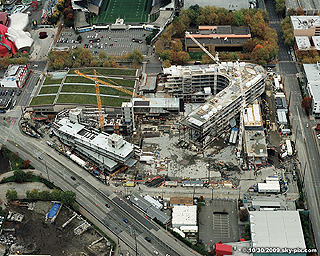|
Subscribe / Renew |
|
|
Contact Us |
|
| ► Subscribe to our Free Weekly Newsletter | |
| home | Welcome, sign in or click here to subscribe. | login |
Real Estate
| |
 |
May 12, 2011
Campus was no ordinary construction project
Sellen Construction

McCleskey
|
The new campus for the Bill & Melinda Gates Foundation is the largest and one of the most complex construction projects ever built by Sellen.
For our construction professionals and craftsmen, the vision created by the foundation provided a once-in-a-lifetime opportunity to be part of something that is changing the world. The local firms and people who built it collaborated to deliver a project with many unique design elements and hundreds of construction challenges.
Construction of the entire campus spanned more than four years. Included were a 1,050-car, five-level underground parking garage completed in 2008, followed by two office buildings totaling 525,000 square feet over the top of a two-level parking structure with an outdoor plaza as the centerpiece.
The project required the collective efforts of more than 2,000 local workers on the site, thousands more in off-site fabrication facilities, and 120 major subcontractors and material suppliers — a much-needed boost to the local economy.
Here are a few noteworthy statistics:
• An 8-acre site
• Removal of 40,000 truckloads of earth
• Installation of 10,000 tons of steel and 6,600 truckloads of concrete (roughly equal to the weight of 1,150 Boeing 787s)
• 170,000 individual plants in the landscaping, including several living roofs
• Nine acres of exterior glass, stone and metal panels
• More than 9,000 sheets of drawings and 18,000 pages of specifications
Two of the biggest construction challenges were also two of the most important design elements: the curving, outward reaching “arms” of each structure; and the large cantilevers, or overhangs, at one end and in the center of each structure.
The curves created complexities for our layout team, from the early foundation work to the final touches. In one especially difficult area, we placed more than 8,000 layout points on the floor to guide the installation of terrazzo flooring details and the intricate ceiling design. 2-D and 3-D building models were often loaded into our sophisticated layout equipment to get everything just right, and to do it efficiently.
The huge cantilevers were especially challenging. To build these we needed to design temporary support structures that were left in place until the permanent steel structure was installed.
The curving cantilever, affectionately known as “the hub,” extended 25 feet beyond the main structure and it supported four floors of office space above. The installation of temporary and permanent steel was a delicate choreography that required a level of precision and timing not often encountered on construction projects.
The design engineers predicted that the permanent structure would flex approximately 2.5 inches once the concrete was placed and windows installed. Our team held its collective breath up to the final installation, with the structure settling almost exactly as predicted.
Wide windows
Another unique design element and construction challenge was the size of the windows, which allow 90 percent of the occupants to have direct daylight into their work spaces.
To maximize daylight, the team specified 10-foot-wide glass panes. Only three firms in the world manufacture glass this wide: two in Europe and one in the U.S.
We worked with all three and ultimately selected the U.S. manufacturer. We then negotiated a contract with Enclos Corp. to fabricate all of the exterior windows and limestone panels in its Utah factory.
These huge individual sections were designed to arrive at the project site and be installed very quickly; one every 30 minutes. The speed of this installation was the most critical work activity on our schedule. Missing our estimate by just a few minutes per panel could have delayed the project by weeks or even months.
Going for gold
The project included many sustainable design details and construction strategies with the goal of a LEED gold rating.
To minimize rainwater runoff we planted more than 2 acres of living roof surfaces throughout the campus. We built a 1 million-gallon storage structure below the garage to collect rainwater from impervious surfaces to be reused to irrigate landscaping, flush toilets, and fill the water features in the outdoor plaza.
We constructed an 800,000-gallon thermal energy storage tank that collects chilled water at night, when energy demand and costs are lowest, to provide building cooling during the day.
Another unique element designed to reduce cooling loads is the automated window blind system that adjusts throughout the day based on the location of the sun and the amount of daylight coming into the office areas.
Other sustainable strategies included buying as much material as possible from regional sources, recycling 95 percent of the waste materials that left the site, sourcing 70 percent of all wood products from sustainably harvested forests, and taking exceptional measures to assure the highest levels of indoor air quality.
Huge project
The biggest challenge for our field team on this project was its sheer size, scope and complexity. At one time there were three tower cranes and six mobile cranes operating alongside a couple dozen forklifts and four temporary elevators attached to the exterior of the buildings.
It was quite a challenge to plan and coordinate the work of so many firms and individuals, and the movement of tons of materials, equipment and finished products — all on a tight budget and schedule in the middle of a busy city. This was successfully accomplished by the dedication and expertise of the project’s managers, designers and constructors.
The most important feature of the project isn’t exactly tangible, but can be seen in every detail of the design and construction. Following the old adage that no great project happens without a great owner, the Gates Foundation pulled together a team of top firms and their most experienced people, and then inspired us all with a strong vision.
The foundation continually reminded us how important we were to its mission, and strived to build and strengthen an atmosphere of trust and respect that touched every single construction worker.
It is not often that Sellen gets an opportunity to be part of a team that is changing the world. From the youngest apprentice to the most seasoned tradesperson, everyone who worked on the Gates Foundation project knows that they helped create not only a lasting gift for the city but, more importantly, a place that will inspire great work for generations.
You can be sure that every last one of us will be driving past the campus for years to come proudly thinking, “I built that.”
Bob McCleskey has been with Sellen for 30 years. He was named president in 2001 and CEO in 2008.
Other Stories:
- Creating a place to solve the world’s challenges
- Engineering makes campus efficient and quiet
- More than meets the eye — below ground
- Landscape is locally rooted at foundation’s campus



